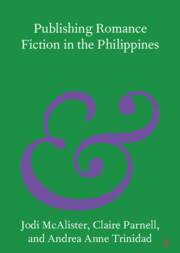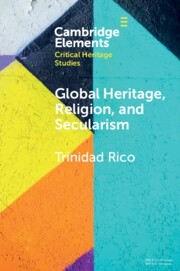130 results
Social participation, loneliness, and physical inactivity over time: evidence from SHARE
-
- Journal:
- International Psychogeriatrics , First View
- Published online by Cambridge University Press:
- 02 April 2024, pp. 1-9
-
- Article
-
- You have access
- Open access
- HTML
- Export citation
PP110 Knowledge Transfer From Scoping Review Into Primary Research In The Context Of Clinical Practice Guidelines Update
-
- Journal:
- International Journal of Technology Assessment in Health Care / Volume 39 / Issue S1 / December 2023
- Published online by Cambridge University Press:
- 14 December 2023, p. S82
-
- Article
-
- You have access
- Export citation

Publishing Romance Fiction in the Philippines
-
- Published online:
- 18 May 2023
- Print publication:
- 08 June 2023
-
- Element
- Export citation
Characterising the cave bear Ursus spelaeus Rosenmüller by ZooMS: a review of peptide mass fingerprinting markers
-
- Journal:
- Earth and Environmental Science Transactions of The Royal Society of Edinburgh / Volume 114 / Issue 1-2 / July 2023
- Published online by Cambridge University Press:
- 27 February 2023, pp. 83-93
- Print publication:
- July 2023
-
- Article
-
- You have access
- Open access
- HTML
- Export citation
A conceptual framework for clinical and translational virtual community engagement research
-
- Journal:
- Journal of Clinical and Translational Science / Volume 6 / Issue 1 / 2022
- Published online by Cambridge University Press:
- 28 October 2022, e136
-
- Article
-
- You have access
- Open access
- HTML
- Export citation
146 Health equity approach to statewide outreach to under-resourced communities during COVID
-
- Journal:
- Journal of Clinical and Translational Science / Volume 6 / Issue s1 / April 2022
- Published online by Cambridge University Press:
- 19 April 2022, p. 13
-
- Article
-
- You have access
- Open access
- Export citation
383 Balancing science policy and patient advocacy in medical education: the case of differences of sex development.
-
- Journal:
- Journal of Clinical and Translational Science / Volume 6 / Issue s1 / April 2022
- Published online by Cambridge University Press:
- 19 April 2022, p. 72
-
- Article
-
- You have access
- Open access
- Export citation
Cochlear implant eligibility in an adult hearing aid population: a multi-perspective service evaluation of a patient referral pathway at a British district general hospital
-
- Journal:
- The Journal of Laryngology & Otology / Volume 136 / Issue 8 / August 2022
- Published online by Cambridge University Press:
- 10 January 2022, pp. 755-759
- Print publication:
- August 2022
-
- Article
- Export citation

Global Heritage, Religion, and Secularism
-
- Published online:
- 03 December 2021
- Print publication:
- 16 December 2021
-
- Element
- Export citation
In support of hybridity. A response to Stephennie Mulder, Ian Straughn and Ruth Young
-
- Journal:
- Archaeological Dialogues / Volume 28 / Issue 2 / December 2021
- Published online by Cambridge University Press:
- 02 December 2021, pp. 127-132
-
- Article
- Export citation
Heritage preservation in religious contexts. Disciplinary challenges for the Middle East and North Africa (MENA) region
-
- Journal:
- Archaeological Dialogues / Volume 28 / Issue 2 / December 2021
- Published online by Cambridge University Press:
- 02 December 2021, pp. 111-120
-
- Article
- Export citation
El Niño Cave (Aýna, Albacete, Spain): Late Middle Palaeolithic, Rock Art, and Neolithic Occupations from Inland Iberia
-
- Journal:
- Proceedings of the Prehistoric Society / Volume 87 / December 2021
- Published online by Cambridge University Press:
- 20 October 2021, pp. 73-81
- Print publication:
- December 2021
-
- Article
- Export citation
Dispute Concerning Delimitation of the Maritime Boundary between Mauritius and Maldives in the Indian Ocean, Preliminary Objections (ITLOS)
-
- Journal:
- International Legal Materials / Volume 60 / Issue 6 / December 2021
- Published online by Cambridge University Press:
- 09 June 2021, pp. 969-1037
- Print publication:
- December 2021
-
- Article
- Export citation
Index
-
- Book:
- The International Court of Justice and Decolonisation
- Published online:
- 13 February 2021
- Print publication:
- 04 March 2021, pp 289-304
-
- Chapter
- Export citation
Table of Cases and Awards
-
- Book:
- The International Court of Justice and Decolonisation
- Published online:
- 13 February 2021
- Print publication:
- 04 March 2021, pp xiv-xviii
-
- Chapter
- Export citation
National Legislation
-
- Book:
- The International Court of Justice and Decolonisation
- Published online:
- 13 February 2021
- Print publication:
- 04 March 2021, pp xxiii-xxiii
-
- Chapter
- Export citation
Contributors
-
- Book:
- The International Court of Justice and Decolonisation
- Published online:
- 13 February 2021
- Print publication:
- 04 March 2021, pp ix-xii
-
- Chapter
- Export citation
Contents
-
- Book:
- The International Court of Justice and Decolonisation
- Published online:
- 13 February 2021
- Print publication:
- 04 March 2021, pp v-vi
-
- Chapter
- Export citation
Table of Legislation
-
- Book:
- The International Court of Justice and Decolonisation
- Published online:
- 13 February 2021
- Print publication:
- 04 March 2021, pp xix-xxi
-
- Chapter
- Export citation
Tables
-
- Book:
- The International Court of Justice and Decolonisation
- Published online:
- 13 February 2021
- Print publication:
- 04 March 2021, pp viii-viii
-
- Chapter
- Export citation



